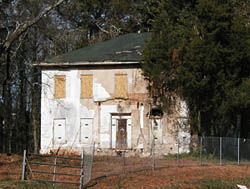Judge William Wilson House facts for kids
|
Judge William Wilson House
|
|
|
Formerly listed on the U.S. National Register of Historic Places
|
|

Judge WIlliam Wilson House
|
|
| Lua error in Module:Location_map at line 420: attempt to index field 'wikibase' (a nil value). | |
| Location | 501 Fairburn Rd., SW, Atlanta, Georgia |
|---|---|
| Area | 15 acres (6.1 ha) |
| Built | 1856 |
| Architectural style | Greek Revival |
| NRHP reference No. | 80001078 |
Quick facts for kids Significant dates |
|
| Added to NRHP | February 15, 1980 |
| Removed from NRHP | November 27, 2020 |
The Judge William Wilson House was a very old and important house in Atlanta, Georgia. It was built before the American Civil War, which is why it's called an antebellum house. The house stood on land that Judge William Wilson inherited from his father. This area was once a community called Adamsville, but over time, it became part of the Fairburn Heights neighborhood in Atlanta.
This house was special because it was one of the last remaining buildings from before the Civil War that was still in its original spot within Atlanta.
Contents
A Historic Atlanta Home
The Judge William Wilson House was built in the Greek Revival style. This style was popular in the mid-1800s and often features columns and grand entrances, similar to ancient Greek temples. The house was constructed between 1856 and 1859. It was the main building of a large farm, or plantation, that covered about 1,200 acres. This made it one of the biggest farms in the area at that time.
The House During the Civil War
During the Battle of Atlanta in the American Civil War, the Judge William Wilson House played a small but interesting role. It was used for a short time by Union General William Tecumseh Sherman as a temporary headquarters. This means he used it as a place to plan and direct his army's actions.
Life After the War
After the Civil War ended, the house remained with the Wilson family. William Asbury Wilson, a member of the family, became an important person in the community. He served in the Georgia General Assembly, which is Georgia's state government. He also worked as a judge and as the sheriff for Fulton County.
The Wilson family owned the house until 1962. At that time, the great-grandson of the original builder sold the property. It was bought by the Holy Family Hospital, which used the house to provide living space for their nurses. Later, the house was used as a community center, a place where people could gather for activities.
The End of a Landmark
By 2011, the Judge William Wilson House was no longer in use. It started to fall apart, with parts of the roof collapsing and cracks appearing in its stone walls. Because of its poor condition, the Atlanta Preservation Center added it to their list of "Most Endangered Properties." This list highlights important buildings that are at risk of being lost forever.
People who cared about preserving old buildings hoped to fix the house and save it. However, in December 2015, the house was torn down without warning. This demolition was a big surprise to the preservation community, who had been working to find a way to protect this historic landmark.

